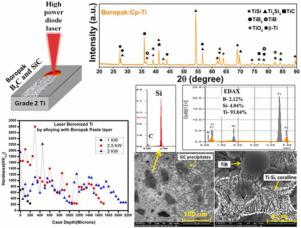Materials Today Communications ( IF 3.7 ) Pub Date : 2022-05-27 , DOI: 10.1016/j.mtcomm.2022.103741 K. Monisha , S.M. Shariff , Ravi Raju , J. Manonmani , Senthilselvan Jayaraman

|
In this work a novel multiphase titanium metal matrix composite (TMMC) coating was developed by high power diode laser assisted alloying of Cp-Ti with the preplaced Boropak powder consisting of B4C and SiC ceramic particles. The XRD, optical microscopy, scanning electron microscopy, EDAX, microhardness and wear testing techniques were employed to investigate structural phase, hardness and wear properties of the alloyed coating. Under the influence of multipass laser alloying, the B4C and SiC ceramic particles decompose to yield boron, silicon and carbon species that react with molten titanium to form TiB2, TiB, TiC and Ti5Si3 phases in the laser alloyed coating. In addition, the un-melted B4C and SiC ceramic particles are dispersed in the titanium matrix. Microstructure of the alloyed coating consists of dendrites and coralline-like structure. The tips of the coralline-like structure are in the range of 150 to 500 nm. The ceramic multiphase TiB2, TiB, TiC and Ti5Si3 formation resulted in average microhardness around 800 - 2200 HV0.2 at different regions of the TMMC coating cross section. To correlate the phase formation and microstructural features, surface temperature evolved at the interaction area during laser surface alloying was estimated by a simple equation. Activation energy for the laser melted track was calculated using the Arhennius equation. The linear reciprocating wear test performed on laser alloyed coating against WC ball showed wear rate value of 1.623 х 10-4 mm3/N.m which is 6 times lower compared to the untreated titanium.
中文翻译:

通过高功率二极管激光将 B4C 和 SiC 颗粒与 Ti 合金化形成硼化钛和硅化钛相:微观结构、硬度和磨损研究
在这项工作中,通过高功率二极管激光辅助 Cp-Ti 与由 B 4 C 和 SiC 陶瓷颗粒组成的预置 Boropak 粉末合金化,开发了一种新型多相钛金属基复合材料 (TMMC) 涂层。采用XRD、光学显微镜、扫描电子显微镜、EDAX、显微硬度和磨损测试技术研究合金涂层的结构相、硬度和磨损性能。在多道次激光合金化的影响下,B 4 C 和 SiC 陶瓷颗粒分解产生硼、硅和碳物质,它们与熔融钛反应在激光合金化涂层中形成 TiB 2、TiB、TiC 和 Ti 5 Si 3相。此外,未熔化的 B 4C和SiC陶瓷颗粒分散在钛基体中。合金涂层的显微结构由枝晶和珊瑚状结构组成。珊瑚状结构的尖端在 150 至 500 nm 范围内。陶瓷多相 TiB 2、TiB、TiC 和 Ti 5 Si 3的形成导致平均显微硬度约为 800 - 2200 HV 0.2在 TMMC 涂层横截面的不同区域。为了关联相的形成和微观结构特征,激光表面合金化过程中相互作用区域的表面温度通过一个简单的方程估算。使用 Arhennius 方程计算激光熔化轨道的活化能。对 WC 球进行激光合金涂层的线性往复磨损测试显示磨损率为 1.623 х 10 -4 mm 3 /Nm,与未经处理的钛相比低 6 倍。

















































 京公网安备 11010802027423号
京公网安备 11010802027423号